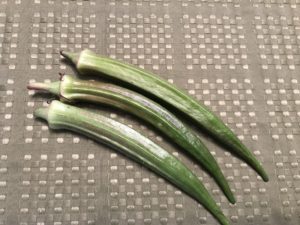Ingredient: Okra
Okra
- Description-
Okra is a member of the mallow family. The edible finger-like seed pods of this flowering plant are sometimes referred to as lady’s fingers.
- Preparation-
Okra has a widely varying taste and texture, depending on how it’s cooked. The pods can release a slimy substance or “mucilage” if stewed, sautéed or steamed. In dry and higher heat settings, it is possible to cook/sear the okra and not release the mucilage, resulting in a varied taste similar to a string bean and eggplant combination. A common “non-slimy” preparation is to be breaded and fried, whereas okra stews or gumbos desire the production of the mucilage during cooking. Okra can also be pickled, or served raw in salads.
- Varieties-
There are many varieties of okra. The one currently shared at the farmstand is an heirloom variety, on the larger side.
- Storage-
Okra can be stored in the fridge for a few days, after that it may be best to freeze/pickle. If you plan to freeze your okra, it needs to be blanched before being frozen.
- Nutrition-
Okra is rich in Calcium, Iron, Magnesium, Potassium and Zinc. it is also high in Vitamins A, B, C, E and K.


